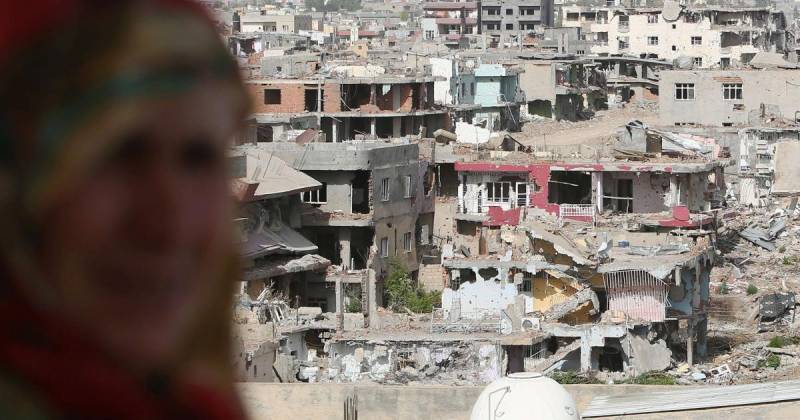[Baysal, an award-winning Ahval columnist, was detained by Turkish authorities on Monday and charged with terror links.]
One year after my last visit, I have returned to the city of Nusaybin along Turkey’s border with Syria. New developments built by the government’s public housing agency, TOKI, are more or less finished. There are still checkpoints at the entrance to the city. Nusaybin is like a giant construction site, littered with potholes, with Turkish flags flying everywhere.
After the breakdown of a two-year ceasefire in the summer of 2015, clashes erupted between security forces and the youth movement of the Kurdistan Workers’ Party (PKK), whose members erected barricades in cities across the mainly Kurdish southeast in response to the movement’s leaders declaring autonomy from the central government.
Starting in March 2016, Nusaybin was put under a 24-hour curfew that lasted 134 days. For close to a year after military operations in the city ended that July, it was impossible to enter six of the city’s most populous neighbourhoods. They had been destroyed by the urban conflict and subsequent redevelopment and encircled in barbed wire. The most vivid image I have of that time, when I visited Nusaybin frequently, is of mothers waiting along these wire fences for the bodies of their children killed in the fighting.
In a sense, Nusaybin has been cut in two: the Nusaybin under curfew and the Nusaybin free from the curfew. These six neighbourhoods, which account for nearly half of the city, were destroyed in front of Nusaybin residents who were waiting outside the fencing day-in and day-out. Some of their children’s bodies were lost under the wreckage, never to be found. Other bodies were only found during the housing construction.
The fencing is gone now, along with the wreckage. It has all been replaced by sterile TOKI buildings, rising amidst parks and gardens. It is hard to believe what happened here in the past few years. The only glimpses into that very recent past are the bullet holes still visible in some of the neighborhood’s doors and walls.
The four-to-five story TOKI buildings, which offer some 5,000 housing units, are surrounded by green spaces and playgrounds, yet the keys to the apartments have not yet been handed out. The state is asking for an additional fee from families whose houses were destroyed. The families are complaining. They are upset because of the additional fees requested by the government, as well as the small size of the apartment units. Considering the average family in Nusaybin has eight to 10 members, the TOKI units are not big enough to accommodate them.
People in Nusaybin generally live in spacious houses with gardens, and the transition from these houses to apartment blocks is difficult. Another issue residents raise is that all of the employees who are to work in the apartments, including the security guards, plumbers, electricians, and so on, will be hired by the state. This concerns families who are supposed to move in. “Now the state is trying to control us through TOKIs,” said one family member.
Another source of pain for everyone is the fact that bodies were buried under the apartments. “We are not happy with the TOKIs, but we have no other choice,” said another person due to move into the new apartments.
It remains unclear how many people died during the fighting. Kurdish authorities I visit tell me that around 100 people from Nusaybin, 20 to 25 of whom were civilians, lost their lives, but no one knows how many soldiers and police officers died. Some say 80 to 85 officers lost their lives.
The city’s population had numbered around 115,000 before the clashes, but is now close to 104,000. Of the 45,000 people who left during the curfews, 11,000 have yet to return. More are staying in nearby towns, while a few moved to western Turkey or fled abroad.
After being governed by a central government-appointed administrator for the past two-and-a-half years, the city is in ruins. The administrator feared bombs could be planted underneath cobblestones and had all of the streets dug up and replaced with asphalt. This asphalt was then torn up to install sewerage pipes. Trenches are everywhere, and dust covers everything.
I navigate through this dust and dirt to visit families that have lost their children. They are very happy to see me. No one has visited them in some time. I will tell their stories separately, because they want their voices to be heard. But what I will say now is that although more than three years have passed since the clashes in Nusaybin, some families are still waiting for their children’s bodies, or working to get a gravestone for their loved ones.
Most have no access to legal aid or support. Their voices have not been heard by anyone and continue to go unnoticed. Everyone I visit wants to talk, to tell their stories. They are still searching for answers to the question, “Why did our children die?” They are critical of the state, as well as the Kurdish movement. One father told me:
“After they had one city destroyed, then a second city, why couldn’t they stop at the third?” One father wondered. “If they had taken a step back at that point, the Kurdish movement would be three steps ahead by now. So many children have died, and yet the man still says that self-governance must win. No one is standing up to admit they made a mistake, to apologise.”
Many families in Nusaybin have been left alone with their pain. Life stood still the day they lost their children, their loved ones, their homes.
As one local told me: “Everyone goes on with their lives, but Nusaybin cannot.”
